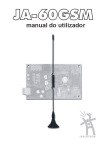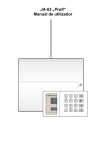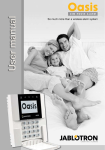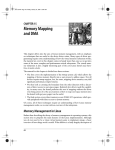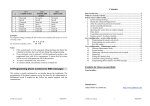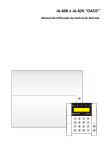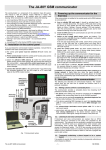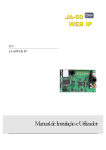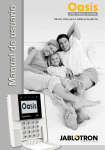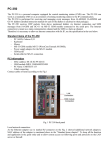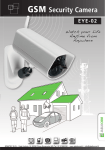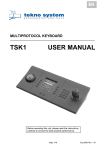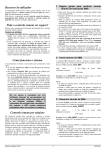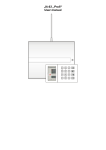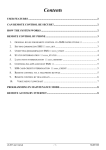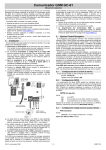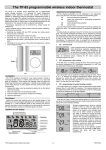Download User manual
Transcript
1. User features of the GSM dialer 5. Web server remote access The JA60GSM dialer offers many useful features described in detail below. The installer should properly demonstrate the use of the system to the user after installation and instruct the user on how to set user access codes. 5.1. Setting possibilities: 1.1. Phone calls from the attached SMS-8010 telephone set (optional accessories) After the GSM module is connected to the GSM network, an attached phone can be used. If you pick up the phone you will hear a dial tone. Simply dial the number you want to call. You can also dial the GSM communicator’s phone number from another phone and the attached phone will ring as a normal landline phone would. If it is necessary to communicate with CMS the call from the attached phone will be terminated in 10 minutes. If a busy tone is generated while the attached phone is being used, it indicates either the line you are calling is busy or that the GSM communicator is busy with a communication (alarm system data transfer has priority). 1.2. Sending SMS messages If used, then the SMS-8010 phone can be used for easy and convenient receiving and sending of SMS messages. The main features of SMS-8010 are: • Making calls – using the receiver or the build-in hands-free set • Writing SMS messages using an alphabetical keypad, message archiving (40 messages) • Call record function – caller identification and date/time • Integrated phonebook records up to 80 phone numbers and names For detailed information see the SMS-8010 manual. 1.3. Telephone remote control of the alarm system A Jablotron system equipped with the GSM dialer can be remotely controlled via a landline or mobile phone. From a mobile phone there are two possibilities – either by text instructions sent via SMS or by dialing-in and operating the system via the phone keypad, which operates in the same way as the alarm system keypad. The dialing-in method can also be preformed from an ordinary landline telephone. The following description matches the factory default settings of the dialer. The described features can be modified during the installation. The installer should explain clearly any changes to the default settings. 1.4. General instructions for the remote control via SMS instructions SMS instructions can be sent from a mobile phone or from Jablotron’s SMS website (www.GSMlink.cz). SMS messages are not case sensitive. Only Standard English letters are accepted. All SMS instruction words must be separated by a space. If the % is used all previous text will be ignored. The %% symbol when used in SMS text ends processing – all the following text will be ignored. It is recommended to use this symbol at the end of the instruction if the provider sends some additional text after your message (advertisements etc.). Warning: if any incoming SMS includes except a valid system command any extra text which is not separated by % or %% symbols the command will not be executed Examples of SMS: “Hi, this text will be ignored even if I write ME % MO %% Thank you” – Only MO command will be executed “Hi, MO” – Command in the SMS will be ignored because there is an extra text The default command texts can be customized by an installer or user (see section 3.3). E.g. the command AUXON can be changed to SWITCH ON HEATING etc. 1.5. Arming by SMS (AM xxxx) The command AM followed by a valid access code is used for arming the alarm system. If the system is already fully armed, this command will be ignored. Send SMS text to the dialer: AM∗xxxx xxxx ∗ is a valid alarm system access code (Master or user). separator (asterisk or space) -2- 5.2. Registration to the web site Registration can be done in two ways: • Web site www.gsmlink.cz – to register your system use the registration code printed on the warranty certificate (the code has a form xxxxx-xxxxx-xxxx and it is unique for each system) • Mobile phone – when the alarm system is in the programming mode, enter 972 xxxxx F0 on the alarm system keypad (xxxxx is your mobile phone number). After a moment you will receive an SMS with a registration code and the system will register to the web server. 5.3. Control panel or GSM dialer setting If you want to set the control panel features you need to know your service and user code. After receiving the correct SMS the GSM dialer will switch to the service mode (disarms and enters the service mode), set the parameters, reads settings and switches back to the chosen mode (service, armed or disarmed). Correct settings and state of the control panel is transferred back to the server. 5.4. Reading of history events History events are readable in any state of the control panel (service code is not needed). One SMS contains 20 events. If it is necessary to read all of the events the GSM dialer will send 7 SMS messages. 6. The Modem function The GSM communicator can also be used as an external modem for accessing the Internet (GPRS format). It is necessary to have the GPRS in the SIM card activated and to have a connection cable connected to the COM port of the PC. Support for MS Windows operating systems can be found on the enclosed CD. The modem can be used only when all reports to the CMS, SMS and system’s calls are executed. When the modem is used: It is possible to use the attached telephone, the internet connection will be temporally suspended Received SMS’s are stored and they will be processed after disconnection of the modem The modem will be disconnected if an alarm or arming event occurs 7. Additional information 7.1. Events reporting priorities: If the dialer is activated to send an events report it will: send information to CMS send SMS reports (1st telephone number, 2nd telephone number,…. 8th tel. number) send audible warnings (1st telephone number, 2nd telephone number,…. 8th tel. number) – each number is called only once, no matter if it is answered or not If any event is triggered which should be reported to a CMS while the alarm system is accessed remotely from a phone, the report will be sent after the remote access is finished. If the user cancels the alarm, all reports, which haven’t been sent yet, will be deleted. This doesn’t included communication with the monitoring station. Example: Sending of AM∗1234 will arm the system in the same way as if the code 1234 is entered on system’s keypad. User manual JA-60GSM The setting server allows a user to read and change the control panel and dialer configuration. Data transfer is made by sending an SMS. The web site allows the user to change: • control panel setting, • dialer setting, • set messages that will be transferred to up to 7 phone numbers, The web site is able to read an event memory of a control panel as well (such as ComLink software). The number of sent data SMS’s is optimized to reduce costs as much as possible. MFJ51808 User manual JA-60GSM - 11 - MFJ51808 The emergency number can be entered by: Notes: 99 xx...x F0 where: xxx…x is a telephone number (max. 20 digits), enter F9 before the number if you need + prefix for international calls 4.6. Remote programming of the alarm via SMS The command PRG is used for sending programming and operating commands to the alarm system. It has the same effect as if the commands are entered on the alarm system keypad. Enter the following command : yyyyy∗PRG∗seq,seq,seq, 1.6. Disarming via SMS (DM xxxx) Command DM followed by a valid access code disarms the system. If the system is already disarmed the command will be ignored. Send SMS text to the dialer: DM∗xxxx where: yyyyy is the remote access code; factory default setting is 1111; this code can be changed, see section 4.1 PRG is the command identification seq are the programming or operating sequences, consisting of characters 0 to 9, F, N. There can be more than one sequence in one SMS. The particular sequences must be separated with a comma or period. The number of sequences in one SMS is only limited by the maximum size of the SMS in the GSM network. ∗ separator (asterisk or space) Example: if the control panel is disarmed and its master code is 1234, then if you want to set user code #2 for the alarm system, use the following command SMS: 1111∗PRG∗F61234 02 6789 After receiving this command message, the new user code (6789) will be added into the control panel. xxxx ∗ is a valid alarm system access code (Master or user) separator (asterisk or space) Example: Sending of DM∗1234 will disarm the system in the same way as if the code 1234 is entered for disarming on system’s keypad. Notes: The system confirms disarming via a reply SMS When system disarming is impossible – for example it is in the programming mode, you will be notified about the situation via a reply SMS. If the alarm system is “split”, the instruction will effect the section which belongs to the corresponding access code If the alarm system is split and the command (AM or DM) is followed by the user code, it will effect the system the same way as if the code is entered from the alarm system keypad – no matter if AM or DM is used (it will arm if the system is disarmed and it will disarm if the system is armed). 4.7. Prepaid SIM cards The JA-60GSM communicator can send information about the credit of a prepaid SIM card. An SMS sent from any of the stored numbers (sequence 7t...) containing the word CREDIT followed by the correct instruction (different for every provider) will result in the sending of the information about the credit. Please ask your mobile phone provider for more information. If you want to check the credit regularly use the following sequence. 1.7. Mode request via SMS (MO) Command MO can be used to read the current alarm system mode. The dialer will reply with a reporting SMS to the phone which sent the MO command about status, level of GSM signal, GPRS status, successfulness of transferring date to the CMSs . Send SMS text to the dialer: MO CREDIT uuu..u xx yyy zz where: uuu…u is the instruction given by the provider for receiving information about the amount of credit xx is the time period (in days) for every checking. yyy is minimum level of credit zz is a position of the credit in the information SMS sent by the provider If the level of the credit is lower than set value (zz) the event “battery discharged GSM communicator” will be sent to the preset telephone numbers. If the credit is restored the event “battery OK GSM communicator” will be sent to the preset telephone numbers. To disable this function set the time (xx) period to 00. Note: • • The system confirms an AM command with a reply SMS. When system arming is impossible e.g. it is in the programming mode, you will be notified about the situation via a reply SMS. If the alarm system is “split” the instruction will effect the section which belongs to the corresponding access code If arming without a code is enabled on the control panel, the AM command can be used without any access code. In this case the command performs the same action as if the keys F 1 are entered on a keypad. Example: If the system is armed, it will reply to the MO instruction with the SMS: Alarm system reports: Control panel status: Armed,GSM:7,GPRS OK,MS1 NOT,MS2 OK Note: if you want to protect this command by a password, set your own command text – see section 3.3. 1.8. Last event request by SMS (ME) Instruction ME is used for reading the last event recorded in the alarm system’s memory. The dialer will reply with a reporting SMS. Send SMS text to the dialer: ME Example: After a fire alarm, it will reply to the ME instruction with the SMS “ Alarm system reports: Last event: Alarm end Control panel Time: 02.06. 19:48 “ Note: if you want to protect this command by a password, set your own instruction text – see 3.3. The user is responsible for the level of the credit The producer does not recommend the use of prepaid cards. 1.9. Remote controlling of an appliance via SMS (AUXON, AUXOFF) These commands can be used for operating the AUX output (e.g. heating in a house). The dialer confirms the command performance via a reply SMS. To switch on the AUX output, send SMS text: To switch off the AUX output, send SMS text: To switch on the PgX(Y) output, send SMS text: To switch off the PgX(Y) output, send SMS text: Example: to switch the heating on send SMS: AUXON User manual JA-60GSM - 10 - MFJ51808 AUXON AUXOFF PGON PGOFF Note: texts of these commands can be customized and protected by a password – see section 3.3. User manual JA-60GSM -3- MFJ51808 1.10. Alarm system remote control via a telephone keypad 4. General settings If you want to operate the alarm system via a phone (mobile or landline), perform the following: Dial the GSM dialer number. An attached telephone will ring. If the phone is not answered the system will answer in 25 seconds - indicated by a short beep. Enter the remote access code; factory default is 1111; to change this code see section 4.1. Confirmation sounds indicate the control panel mode: 1 beep = armed, 2 beeps = disarmed, 3 beeps = programming mode, Siren sound = alarm. From this moment the telephone keypad will work as the alarm control panel keypad. Key E is interpreted as F, key # as N. To terminate the connection simply hang up. Connection will automatically terminate if there is no entry within 60 seconds. Notes: Remote access from a landline is only possible from a phone using tone dialing (DTMF) It is impossible to operate the system remotely without a valid remote access code (if used). 1.11. Remote controlling of an appliance via a telephone keypad If you want to operate outputs PgX or PgY (e.g. an appliance in the house) from a phone (mobile or landline), perform the following: Enter the user mode (see section2.) before using any of the following sequences. 4.1. Remote access code 9 4 xxxxxxxx F1 where: xxxxxxxx is the code, it can have from 1 to 8 digits If you enter 94F1 - the code is erased and the remote access to the alarm system is not allowed. Default setting: 1111 4.2. One-time dialing-in when in user mode While the control panel is in the user mode, you can enable one-time remote access by entering 970. After entering this code the dialer responds to the first ring of any incoming call. The access code is not requested, so the calling phone keypad can be immediately used as the keypad of the alarm system (* = F, # = N). The immediate dialing-in will be disabled after you dial-in or after you exit the programming mode. 4.3. GSM signal monitoring The proper function of the GSM dialer is conditional on the GSM signal being strong enough. Enter 971 to measure the GSM signal level. The keypad’s display shows a number from 0 to 9 and it beeps every second indicating a new measurement. For proper functioning of the module the signal level should be 3 or higher. Find the best location for the antenna while measuring the signal level. a) Dial the GSM dialer number. An attached telephone will ring. b) If the phone is not answered, the system will answer in 25 seconds - indicated by a short beep. c) Enter the remote user access code; factory default setting is 1111; to change this code see section 4.1. d) The system will confirm the validity of the code with a beep. 4.4. Attached phone function e) From this moment you can operate the PgX and PgY outputs by entering: The dialer provides a PHONE output to connect an ordinary telephone set. The function of this telephone can be modified by entering: 80 - to switch off To switch the system back to the user mode press the N key. 98 y 81 - to switch on (permanently) f) To terminate the connection simply hang up. Connection will automatically terminate if there is no entry within 60 seconds. Notes: Remote access from a land line is only possible from a phone using tone dialing (DTMF) If the system is programmed to allow control only with a valid code the control sequence must be complete with a user code: (∗8[code]0 or ∗8[code]1). For using this function the alarm system must support F 81 and F 80 sequences 1.12. a) From an authorized phone dial the JA-60GSM phone number. The SP-01 will ring once and then it will answer the call b) Potential alarm on the control panel will be terminated c) You can talk to the premises d) For switching to the listening mode press 5 on your phone. For switching back to the talking mode press key 2. Or by pressing button 1 it is possible to toggle between talking and listening. e) Note: Only a phone with available DTMF can be used. User manual JA-60GSM -4- ordinary telephone line is simulated, it is possible to make phone calls (indicated by a dial tone in the receiver) if you pick up the receiver, the telephone keypad will work as the keypad of the alarm system. It is impossible to make phone calls in this mode (you will hear sounds of the alarm keypad in the receiver) disabled - the telephone has no function emergency call – if you pick-up the phone, it will dial the emergency number (see section 4.5) y=2 y=3 Notes: Press 0 or hang-up to terminate the call. function y=0 y=1 Remote voice communication with premises If the SP-01 intercom is plug-in to the PHONE terminal (it must not be combined with any phone connected) it is possible to create a one way (talking or listening) communication from an authorized (stored) phone numbers (see 2.1.). Procedure: where It is possible to switch from mode 0 (ordinary telephone line simulation) to mode 1 (alarm system keypad) by pressing the “#” key (handset must be picked-up). The phone will return to mode 0 after being hung-up. In mode 3 (emergency call) it is possible (within 2 seconds after picking the handset up) to switch to mode 0 (ordinary telephone line simulation) or mode 1 (alarm system keypad) by pressing the “ *” or ” #“ key. 4.5. Emergency call number setting If the attached telephone is programmed for emergency calls (see section 4.4), it will dial the emergency number after the handset is picked up. User manual JA-60GSM MFJ51808 -9- MFJ51808 3.3. SMS texts editing 2. SMS and audible alarm reports setting The list of SMS texts stored in the dialer consists of texts reported as event reports (installation name, event name and source name) and texts for remote control instructions. All these texts can be edited by the following SMS sent from a mobile phone. yyyyy∗TXT∗z,text, z,text where: yyyyy TXT z , text ∗ is the remote access code; default setting is 1111; this code can be changed, see section 4.1 is the text programming command is the text index (110 - 711 see table 3.3.1). comma (separator) is the new text string. Neither a comma nor a dot can be used inside the text. Space inside the text is a valid character (dialer ignores spaces out of the “text” string) separator (asterisk or space) Note: If you change texts of command SMS this way (texts no. 703 to 711), then you will actually change the commands which the system reacts to. E.g.: if you change text „MO“ (text no. 705) to „STATE OF THE ALARM SYSTEM?“ then this command can only be used to learn the status of the system. You can change texts for your needs and also insert a password to protect against unauthorized use of SMS commands. The following information is for use by an alarm system administrator who knows the master code. All settings can be programmed via a keypad. A sequence can be canceled anytime by pressing the “N” key (e.g. entry error). When a sequence is complete, the system will store it into the memory. The following settings are made in the user mode, which can be entered by: F 0 master code. (this mode is indicated by the “U” character on the keypad’s LED display). Example: If the master code is 1234 then enter: F0 1234 Press “N” to exit the user mode. 2.1. Telephone numbers setting The dialer has 8 telephone number memories. Each memory has particular SMS reports assigned to it and/or audible warnings according to the default setting – see table 2.2. By entering a telephone number to a particular memory selects what will be reported to this number: 7t xxx...x F0 Example: If the factory default code for the dialer is 1111, then the sending of SMS: 1111*TXT*201, uncle Sam’s controller, 202, aunt Mary’s controller to the dialer will change names of remote controllers No. 1 and 2. 3.3.1. The factory default settings allow the GSM dialer to send SMS reports and audible warnings when the control panel generates important pertinent information (alarms, arming, etc.). It is only necessary to set the telephone numbers to where the information should be reported. If you want to report additional or different events than the factory default provides, see section 3. where: t xxx...x Table of SMS texts Text index z Factory default text 110 201 202 203 204 205 206 207 208 501 502 503 504 505 506 507 508 509 510 511 512 513 514 700 703 704 705 706 707 708 710 711 Master code Controller #1 Controller #2 Controller #3 Controller #4 Controller #5 Controller #6 Controller #7 Controller #8 User code #1 User code #2 User code #3 User code #4 User code #5 User code #6 User code #7 User code #8 User code #9 User code #10 User code #11 User code #12 User code #13 User code #14 Alarm system reports: AM DM MO ME AUXON AUXOFF PGON PGOFF User manual JA-60GSM Text index z 301 302 303 304 305 306 307 308 309 310 311 312 313 314 315 316 401 402 403 404 405 406 407 408 409 410 411 412 413 414 415 416 -8- Factory default text is a memory from 1 to 7 is a telephone number (max. 20 digits), enter F9 before the number, if you need + prefix for international calls. To use an attached SMS phone set enter code 001 instead of the telephone number To disable reporting to a particular number, delete this number from the memory by entering: Wired detector #1 Wired detector #2 Wired detector #3 Wired detector #4 Wired detector #5 Wired detector #6 Wired detector #7 Wired detector #8 Wired detector #9 Wired detector #10 Wired detector #11 Wired detector #12 Wired detector #13 Wired detector #14 Wired detector #15 Wired detector #16 Wireless detector #1 Wireless detector #2 Wireless detector #3 Wireless detector #4 Wireless detector #5 Wireless detector #6 Wireless detector #7 Wireless detector #8 Wireless detector #9 Wireless detector #10 Wireless detector #11 Wireless detector #12 Wireless detector #13 Wireless detector #14 Wireless detector #15 Wireless detector #16 7tF0 where: t is a memory from 1 to 7 Report testing: If you wish to report any alarm, arming and disarming via an SMS followed by a notifying call and your mobile phone number is 123456789, then enter 75123456789F0 (while the control panel is in the programming mode). Then exit the programming mode by pressing the N key. Now when you arm the system your mobile phone will receive a reporting SMS. Notes: For SMS transfers use only numbers of mobile phones or call centers that can transfer SMS messages. Audible warnings can be used on both GSM and landline networks. The GSM dialer can report all event information from the alarm system via SMS and audible warnings. The setting of reported events for all numbers can be changed – see chapter 3. 2.2. Telephone numbers table Memory Entering sequence 1. 71 ____ F0 To this pair of numbers will be sent (factory default): Telephone numbers - ALARM SMS - Technical SMS 2. 72 ____ F0 MFJ51808 User manual JA-60GSM -5- MFJ51808 3.2.1. Table – SMS reports assignments to telephone numbers 3. 73 ____ F0 - ALARM SMS - ALARM CALL (audible warning) 4. 74 ____ F0 5. 75 ____ F0 6. 76 ____ F0 7. 77 ____ F0 - Any ALARM, ARMING & DISARMING SMS. - ALARM CALL (audible warning) - Technical SMS - ALARM CALL (audible warning) Technical SMS about events in the system. This position is reserved for service organization. 8. 3. Customization of SMS and audible warnings The dialer can report all possible events of the alarm system via SMS (see table 3.2.1.). There are factory default SMS texts available for all possible events and for all possible sources of the events. All texts can be edited. It is possible to set which events will be reported to which telephone number. It is possible to set which events should activate audible warnings. It is possible to change incoming SMS command texts, which are used for remote controlling of the system. The control panel must be in the user mode (see section 2) to be able to use the following programming sequences: 3.1. Events to be reported by SMS Table 3.2.1 shows the complete list of all possible events in the alarm system. It also shows which events are assigned to which telephone numbers to be reported via SMS. You can make your own setting by: 81 uu t y where: uu t y is an event index from 01 to 31 is a telephone number memory from1 to 7 0 = reporting disabled, 1 = reporting enabled Example: if you enter 810371 and a Fire alarm is triggered (event index 03) by detector number 1, the following message will be sent to the 7th telephone number: “Alarm system reports: Fire alarm Wireless detector #1 Time: 16.04. 11:16” Note: SMS reports consist of 4 text parts (installation name, event name, source name and time) – all of these texts can be edited, see section 3.3 for details. 3.2. Assignment of audible warnings to be reported Table 3.2.1 also shows the complete list of all possible events in the alarm system. It shows which events are assigned to which telephone numbers to be audibly reported. You can make your own setting by: 82 uu t y where: uu t y User manual JA-60GSM is an event index from 01 to 31 is a telephone number memory from1 to 7 0 = reporting disabled, 1 = reporting enabled -6- MFJ51808 User manual JA-60GSM -7- MFJ51808






